KIA STONIC 2018 Owners Manual
Manufacturer: KIA, Model Year: 2018, Model line: STONIC, Model: KIA STONIC 2018Pages: 523, PDF Size: 24.99 MB
Page 411 of 523
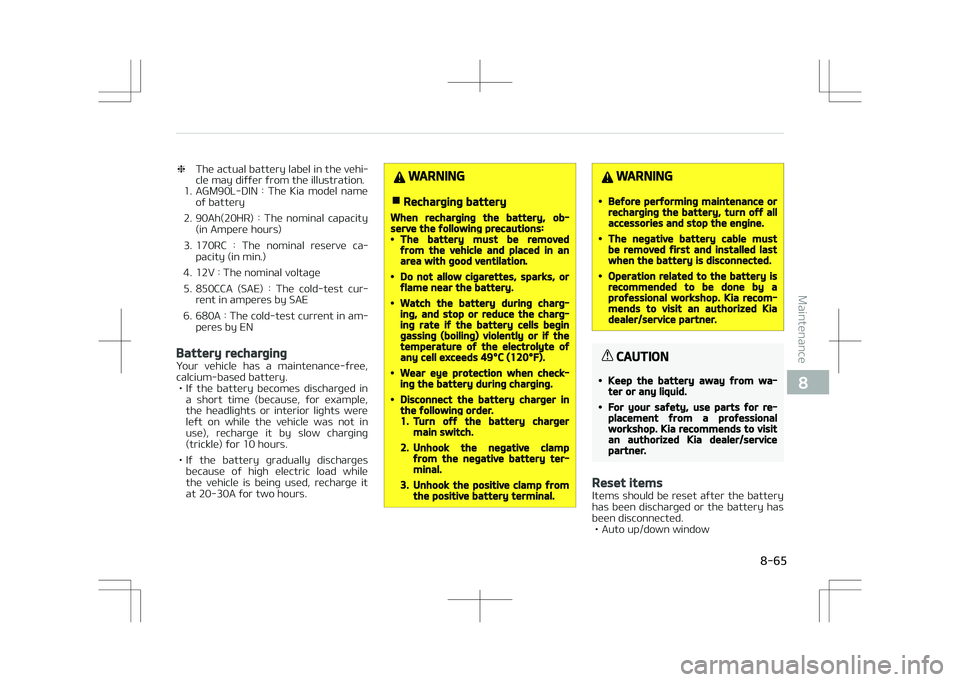
❈The actual battery label in the vehi‐
cle may differ from the illustration.
1. AGM90L-DIN : The Kia model name
of battery
2. 90Ah(20HR) : The nominal capacity (in Ampere hours)
3. 170RC : The nominal reserve ca‐ pacity (in min.)
4. 12V : The nominal voltage
5. 850CCA (SAE) : The cold-test cur‐ rent in amperes by SAE
6. 680A : The cold-test current in am‐ peres by EN
Battery recharging
Your vehicle has a maintenance-free,
calcium-based battery. • If the battery becomes discharged in a short time (because, for example,the headlights or interior lights were
left on while the vehicle was not in
use), recharge it by slow charging
(trickle) for 10 hours.
• If the battery gradually discharges because of high electric load while
the vehicle is being used, recharge it
at 20-30A for two hours.
WARNING
nRecharging battery
When recharging the battery, ob‐serve the following precautions:•The battery must be removedfrom the vehicle and placed in anarea with good ventilation.
•Do not allow cigarettes, sparks, orflame near the battery.
•Watch the battery during charg‐ing, and stop or reduce the charg‐ing rate if the battery cells begingassing (boiling) violently or if thetemperature of the electrolyte ofany cell exceeds 49°C (120°F).
•Wear eye protection when check‐ing the battery during charging.
•Disconnect the battery charger inthe following order.1.Turn off the battery chargermain switch.
2.Unhook the negative clampfrom the negative battery ter‐minal.
3.Unhook the positive clamp fromthe positive battery terminal.
WARNING
•Before performing maintenance orrecharging the battery, turn off allaccessories and stop the engine.
•The negative battery cable mustbe removed first and installed lastwhen the battery is disconnected.
•Operation related to the battery isrecommended to be done by aprofessional workshop. Kia recom‐mends to visit an authorized Kiadealer/service partner.
CAUTION
•Keep the battery away from wa‐ter or any liquid.
•For your safety, use parts for re‐placement from a professionalworkshop. Kia recommends to visitan authorized Kia dealer/servicepartner.
Reset items
Items should be reset after the battery
has been discharged or the battery has been disconnected. • Auto up/down window
8-65
8
Maintenance
Page 412 of 523
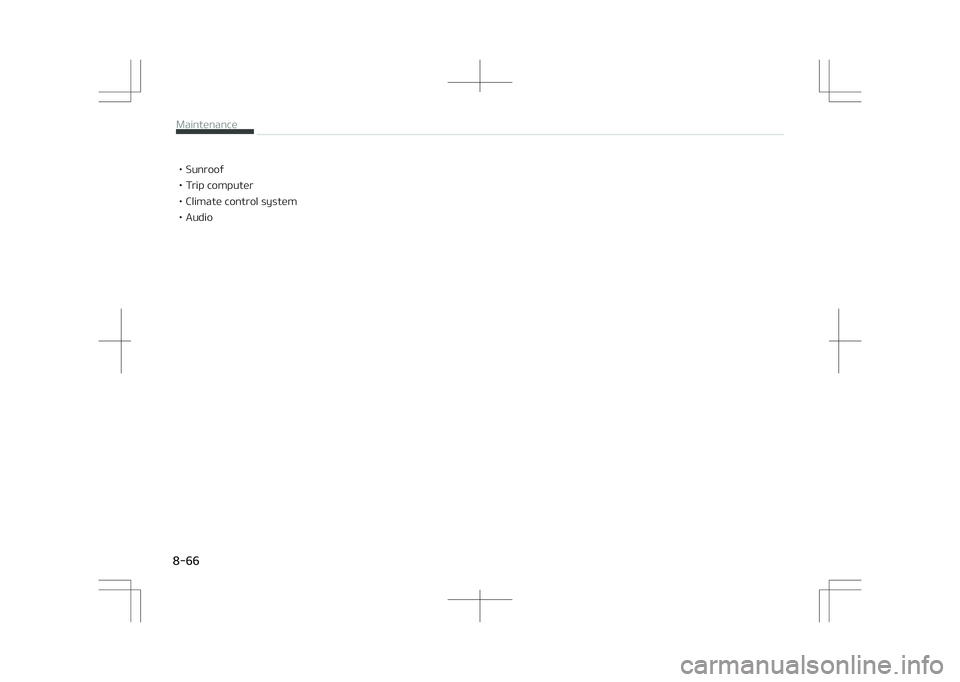
• Sunroof
• Trip computer
• Climate control system
• Audio
Maintenance
8-66
Page 413 of 523
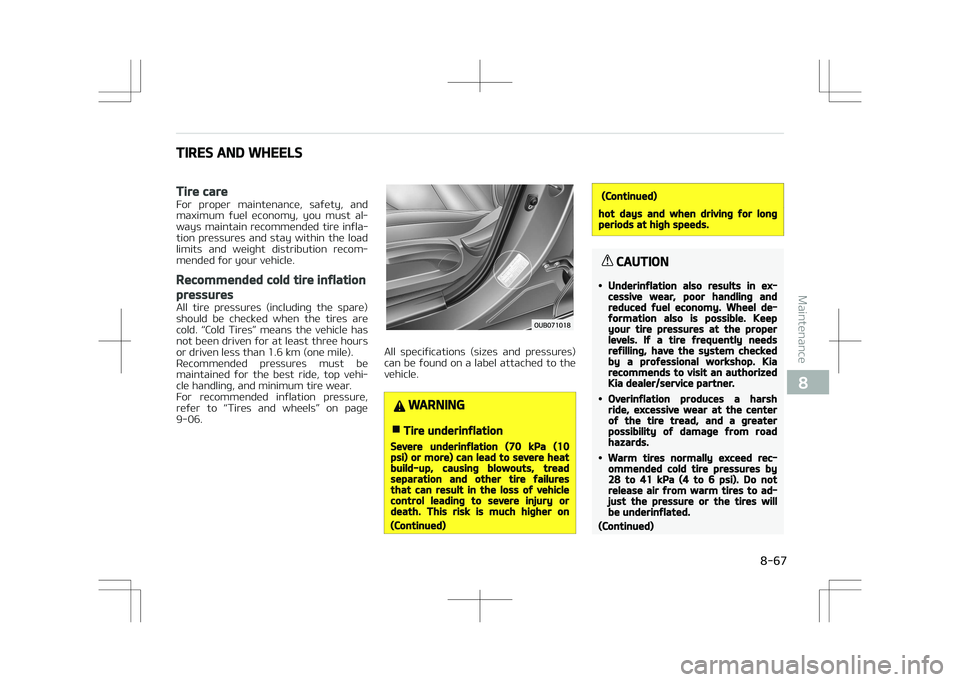
TIRES AND WHEELS
Tire care
For proper maintenance, safety, and
maximum fuel economy, you must al‐
ways maintain recommended tire infla‐ tion pressures and stay within the load
limits and weight distribution recom‐
mended for your vehicle.
Recommended cold tire inflation
pressures
All tire pressures (including the spare)
should be checked when the tires are cold. L
Page 414 of 523
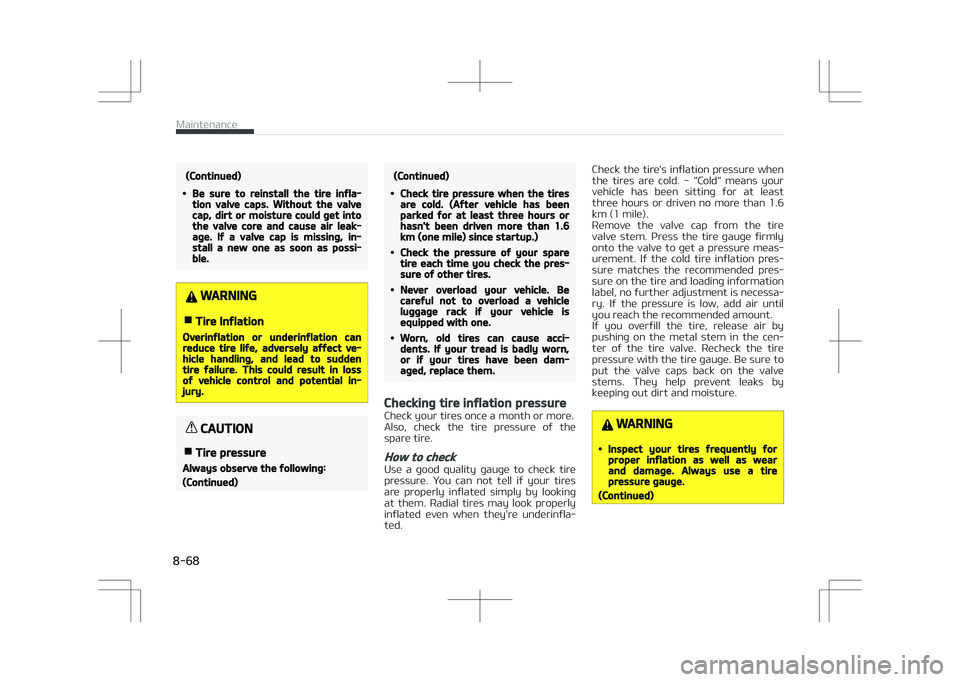
(Continued)
•Be sure to reinstall the tire infla‐tion valve caps. Without the valvecap, dirt or moisture could get intothe valve core and cause air leak‐age. If a valve cap is missing, in‐stall a new one as soon as possi‐ble.
WARNING
nTire Inflation
Overinflation or underinflation canreduce tire life, adversely affect ve‐hicle handling, and lead to suddentire failure. This could result in lossof vehicle control and potential in‐jury.
CAUTION
nTire pressure
Always observe the following:
(Continued)
(Continued)
•Check tire pressure when the tiresare cold. (After vehicle has beenparked for at least three hours orhasn't been driven more than 1.6km (one mile) since startup.)
•Check the pressure of your sparetire each time you check the pres‐sure of other tires.
•Never overload your vehicle. Becareful not to overload a vehicleluggage rack if your vehicle isequipped with one.
•Worn, old tires can cause acci‐dents. If your tread is badly worn,or if your tires have been dam‐aged, replace them.
Checking tire inflation pressure
Check your tires once a month or more.
Also, check the tire pressure of the
spare tire.
How to check
Use a good quality gauge to check tire
pressure. You can not tell if your tires
are properly inflated simply by looking
at them. Radial tires may look properly
inflated even when they're underinfla‐ ted. Check the tire's inflation pressure when
the tires are cold. - "Cold" means your
vehicle has been sitting for at least three hours or driven no more than 1.6
km (1 mile).
Remove the valve cap from the tire
valve stem. Press the tire gauge firmly onto the valve to get a pressure meas‐
urement. If the cold tire inflation pres‐
sure matches the recommended pres‐ sure on the tire and loading information
label, no further adjustment is necessa‐
ry. If the pressure is low, add air until
you reach the recommended amount.
If you overfill the tire, release air by pushing on the metal stem in the cen‐
ter of the tire valve. Recheck the tire
pressure with the tire gauge. Be sure to put the valve caps back on the valve
stems. They help prevent leaks by
keeping out dirt and moisture.
WARNING
•Inspect your tires frequently forproper inflation as well as wearand damage. Always use a tirepressure gauge.
(Continued)
Maintenance
8-68
Page 415 of 523
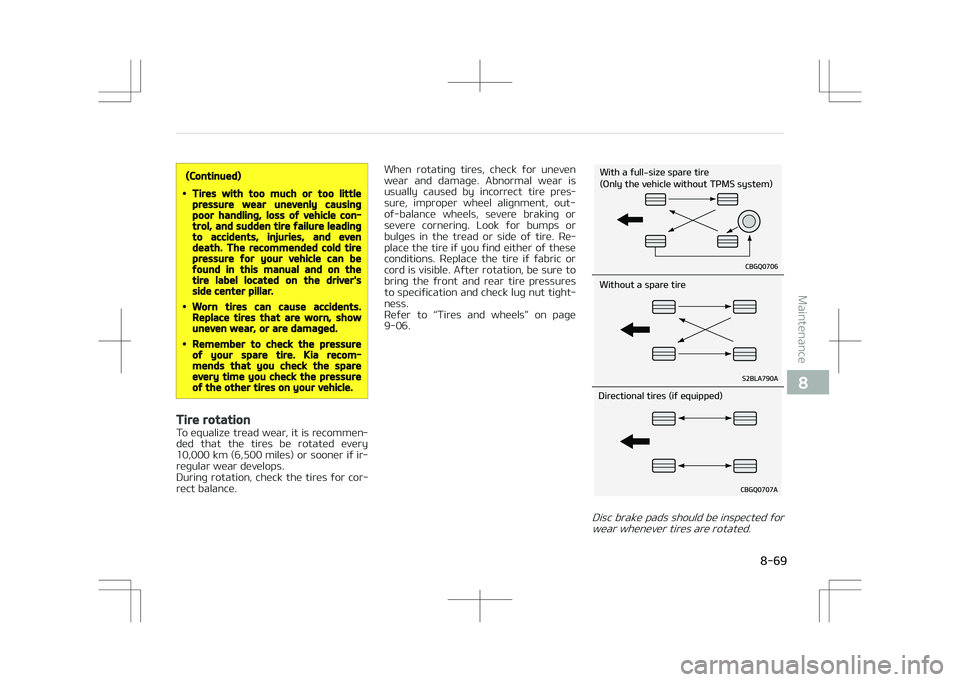
(Continued)
•Tires with too much or too littlepressure wear unevenly causingpoor handling, loss of vehicle con‐trol, and sudden tire failure leadingto accidents, injuries, and evendeath. The recommended cold tirepressure for your vehicle can befound in this manual and on thetire label located on the driver'sside center pillar.
•Worn tires can cause accidents.Replace tires that are worn, showuneven wear, or are damaged.
•Remember to check the pressureof your spare tire. Kia recom‐mends that you check the spareevery time you check the pressureof the other tires on your vehicle.
Tire rotation
To equalize tread wear, it is recommen‐
ded that the tires be rotated every 10,000 km (6,500 miles) or sooner if ir‐
regular wear develops.
During rotation, check the tires for cor‐
rect balance. When rotating tires, check for uneven
wear and damage. Abnormal wear is
usually caused by incorrect tire pres‐
sure, improper wheel alignment, out- of-balance wheels, severe braking or
severe cornering. Look for bumps or
bulges in the tread or side of tire. Re‐ place the tire if you find either of these
conditions. Replace the tire if fabric or
cord is visible. After rotation, be sure to bring the front and rear tire pressures
to specification and check lug nut tight‐
ness.
Refer to L
Page 416 of 523
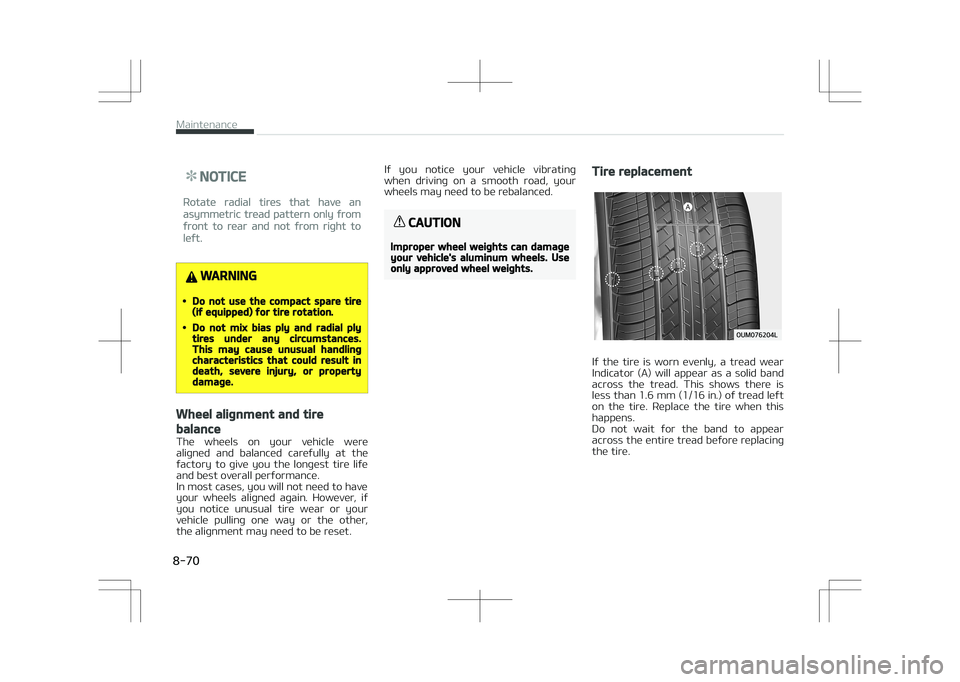
NOTICE
Rotate radial tires that have an
asymmetric tread pattern only from
front to rear and not from right to
left.
WARNING
•Do not use the compact spare tire(if equipped) for tire rotation.
•Do not mix bias ply and radial plytires under any circumstances.This may cause unusual handlingcharacteristics that could result indeath, severe injury, or propertydamage.
Wheel alignment and tire
balance
The wheels on your vehicle were
aligned and balanced carefully at the factory to give you the longest tire life
and best overall performance.
In most cases, you will not need to have
your wheels aligned again. However, if
you notice unusual tire wear or your vehicle pulling one way or the other,
the alignment may need to be reset. If you notice your vehicle vibrating
when driving on a smooth road, your wheels may need to be rebalanced.
CAUTION
Improper wheel weights can damageyour vehicle's aluminum wheels. Useonly approved wheel weights.
Tire replacement
If the tire is worn evenly, a tread wear
Indicator (A) will appear as a solid band across the tread. This shows there is
less than 1.6 mm (1/16 in.) of tread left
on the tire. Replace the tire when this happens.
Do not wait for the band to appear
across the entire tread before replacing
the tire.
Maintenance
8-70
Page 417 of 523
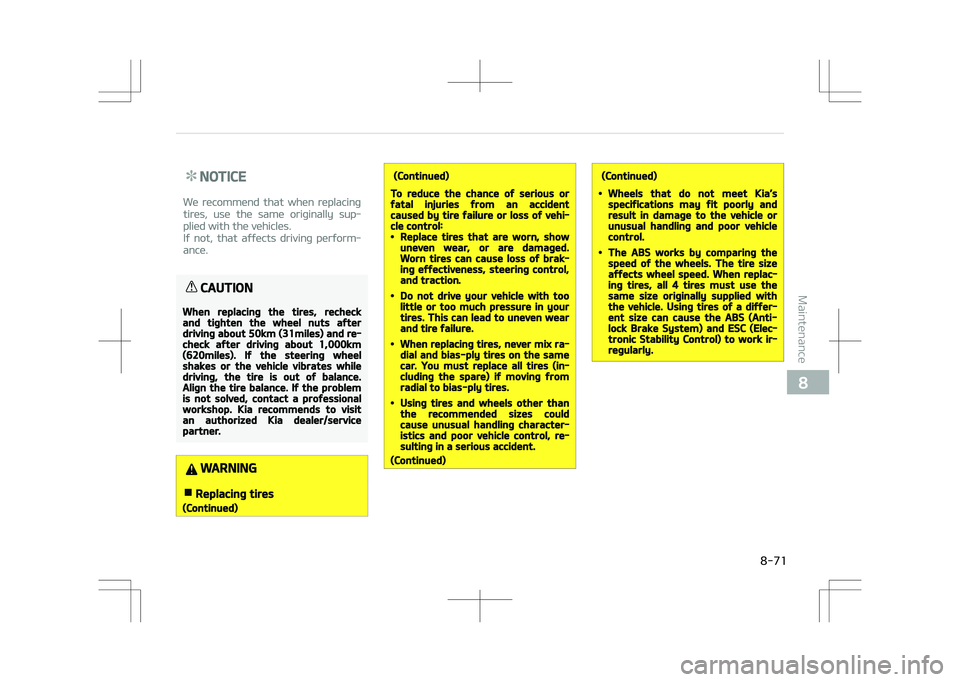
NOTICE
We recommend that when replacing
tires, use the same originally sup‐
plied with the vehicles.
If not, that affects driving perform‐
ance.
CAUTION
When replacing the tires, recheckand tighten the wheel nuts afterdriving about 50km (31miles) and re‐check after driving about 1,000km(620miles). If the steering wheelshakes or the vehicle vibrates whiledriving, the tire is out of balance.Align the tire balance. If the problemis not solved, contact a professionalworkshop. Kia recommends to visitan authorized Kia dealer/servicepartner.
WARNING
nReplacing tires
(Continued)
(Continued)
To reduce the chance of serious orfatal injuries from an accidentcaused by tire failure or loss of vehi‐cle control:•Replace tires that are worn, showuneven wear, or are damaged.Worn tires can cause loss of brak‐ing effectiveness, steering control,and traction.
•Do not drive your vehicle with toolittle or too much pressure in yourtires. This can lead to uneven wearand tire failure.
•When replacing tires, never mix ra‐dial and bias-ply tires on the samecar. You must replace all tires (in‐cluding the spare) if moving fromradial to bias-ply tires.
•Using tires and wheels other thanthe recommended sizes couldcause unusual handling character‐istics and poor vehicle control, re‐sulting in a serious accident.
(Continued)
(Continued)
•Wheels that do not meet Kia’sspecifications may fit poorly andresult in damage to the vehicle orunusual handling and poor vehiclecontrol.
•The ABS works by comparing thespeed of the wheels. The tire sizeaffects wheel speed. When replac‐ing tires, all 4 tires must use thesame size originally supplied withthe vehicle. Using tires of a differ‐ent size can cause the ABS (Anti-lock Brake System) and ESC (Elec‐tronic Stability Control) to work ir‐regularly.
8-71
8
Maintenance
Page 418 of 523
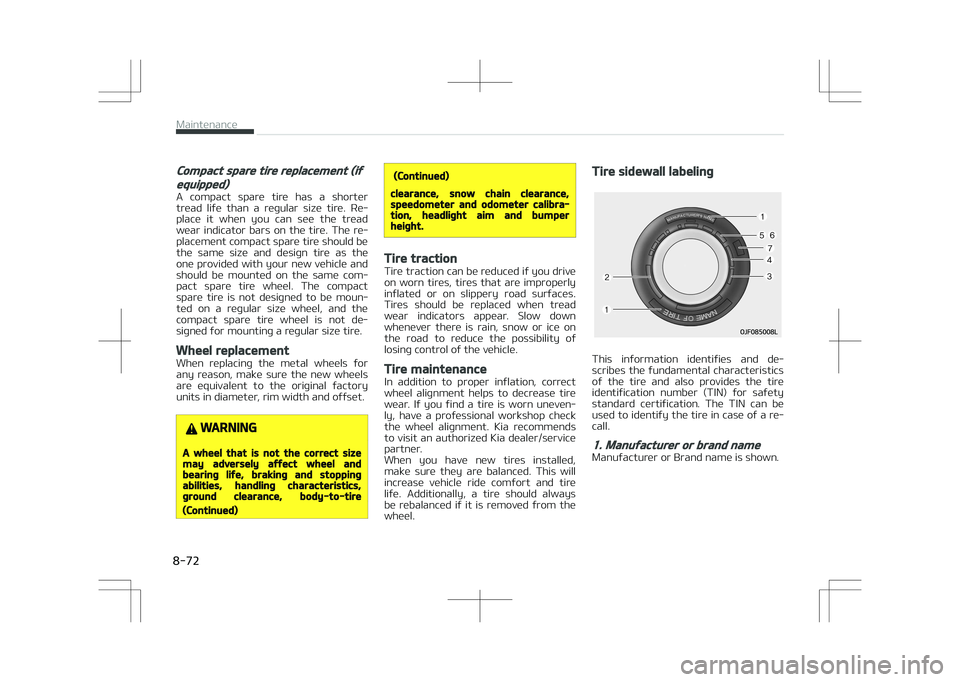
Compact spare tire replacement (if
equipped)
A compact spare tire has a shortertread life than a regular size tire. Re‐
place it when you can see the tread
wear indicator bars on the tire. The re‐ placement compact spare tire should be
the same size and design tire as the
one provided with your new vehicle and
should be mounted on the same com‐ pact spare tire wheel. The compact
spare tire is not designed to be moun‐
ted on a regular size wheel, and the compact spare tire wheel is not de‐
signed for mounting a regular size tire.
Wheel replacement
When replacing the metal wheels for
any reason, make sure the new wheels are equivalent to the original factory
units in diameter, rim width and offset.
WARNING
A wheel that is not the correct sizemay adversely affect wheel andbearing life, braking and stoppingabilities, handling characteristics,ground clearance, body-to-tire
(Continued)
(Continued)
clearance, snow chain clearance,speedometer and odometer calibra‐tion, headlight aim and bumperheight.
Tire traction
Tire traction can be reduced if you drive
on worn tires, tires that are improperly inflated or on slippery road surfaces.
Tires should be replaced when tread
wear indicators appear. Slow down whenever there is rain, snow or ice on
the road to reduce the possibility of
losing control of the vehicle.
Tire maintenance
In addition to proper inflation, correct
wheel alignment helps to decrease tire wear. If you find a tire is worn uneven‐
ly, have a professional workshop check
the wheel alignment. Kia recommends to visit an authorized Kia dealer/service
partner.
When you have new tires installed,
make sure they are balanced. This will increase vehicle ride comfort and tire
life. Additionally, a tire should always
be rebalanced if it is removed from the wheel.
Tire sidewall labeling
This information identifies and de‐
scribes the fundamental characteristics of the tire and also provides the tire
identification number (TIN) for safety
standard certification. The TIN can be used to identify the tire in case of a re‐
call.
1. Manufacturer or brand name
Manufacturer or Brand name is shown.
Maintenance
8-72
Page 419 of 523
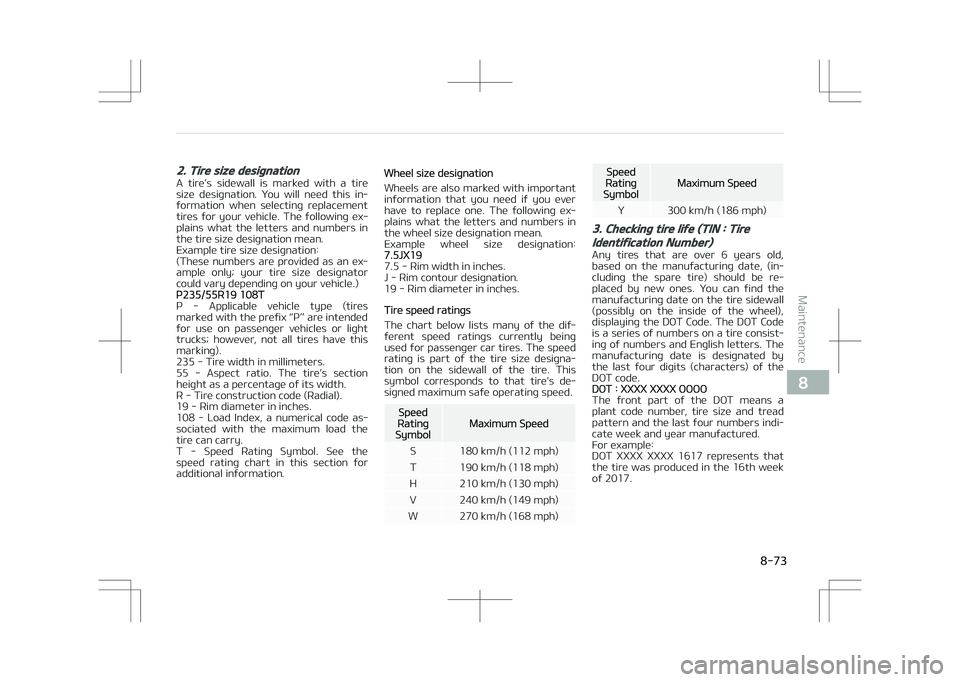
2. Tire size designation
A tire’s sidewall is marked with a tiresize designation. You will need this in‐
formation when selecting replacement
tires for your vehicle. The following ex‐ plains what the letters and numbers in
the tire size designation mean.
Example tire size designation:
(These numbers are provided as an ex‐
ample only; your tire size designator could vary depending on your vehicle.)
P235/55R19 108T
P - Applicable vehicle type (tires
marked with the prefix L
Page 420 of 523
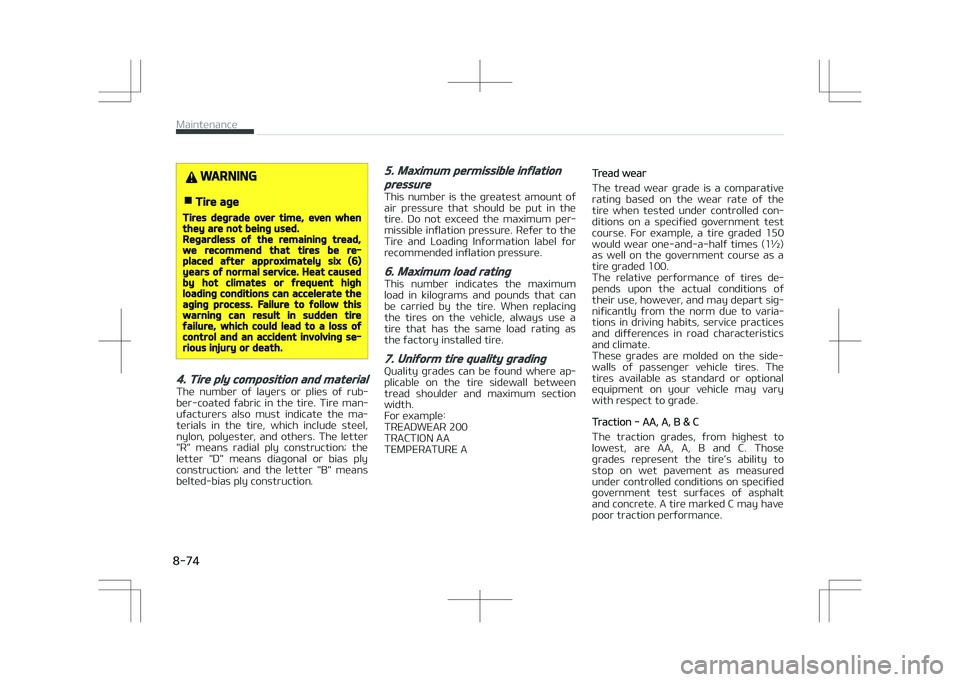
WARNING
nTire age
Tires degrade over time, even whenthey are not being used.Regardless of the remaining tread,we recommend that tires be re‐placed after approximately six (6)years of normal service. Heat causedby hot climates or frequent highloading conditions can accelerate theaging process. Failure to follow thiswarning can result in sudden tirefailure, which could lead to a loss ofcontrol and an accident involving se‐rious injury or death.
4. Tire ply composition and material
The number of layers or plies of rub‐
ber-coated fabric in the tire. Tire man‐ ufacturers also must indicate the ma‐
terials in the tire, which include steel,
nylon, polyester, and others. The letter "R" means radial ply construction; the
letter "D" means diagonal or bias ply
construction; and the letter "B" means belted-bias ply construction.
5. Maximum permissible inflation
pressure
This number is the greatest amount of
air pressure that should be put in the
tire. Do not exceed the maximum per‐ missible inflation pressure. Refer to the
Tire and Loading Information label for
recommended inflation pressure.
6. Maximum load rating
This number indicates the maximum
load in kilograms and pounds that can be carried by the tire. When replacing
the tires on the vehicle, always use a
tire that has the same load rating as the factory installed tire.
7. Uniform tire quality grading
Quality grades can be found where ap‐
plicable on the tire sidewall between tread shoulder and maximum section
width.
For example:TREADWEAR 200TRACTION AA
TEMPERATURE A
Tread wear
The tread wear grade is a comparative
rating based on the wear rate of the tire when tested under controlled con‐
ditions on a specified government test
course. For example, a tire graded 150 would wear one-and-a-half times (1½)
as well on the government course as a
tire graded 100.
The relative performance of tires de‐ pends upon the actual conditions of
their use, however, and may depart sig‐
nificantly from the norm due to varia‐
tions in driving habits, service practices and differences in road characteristics
and climate.
These grades are molded on the side-
walls of passenger vehicle tires. The tires available as standard or optional
equipment on your vehicle may vary
with respect to grade.
Traction - AA, A, B & C
The traction grades, from highest to lowest, are AA, A, B and C. Those
grades represent the tire’s ability to
stop on wet pavement as measured under controlled conditions on specified
government test surfaces of asphalt
and concrete. A tire marked C may have poor traction performance.
Maintenance
8-74